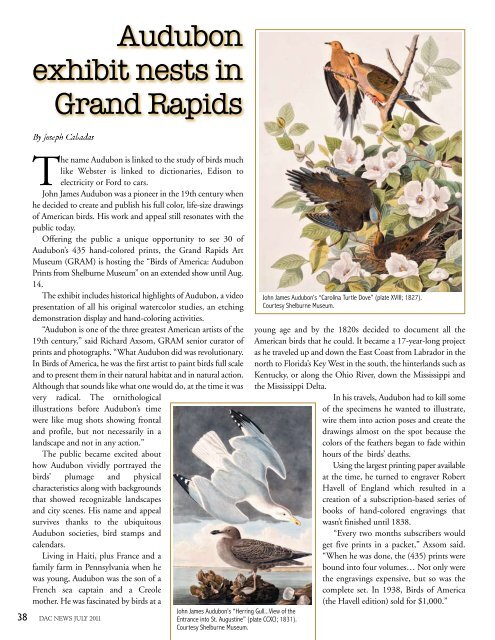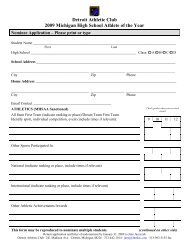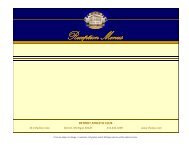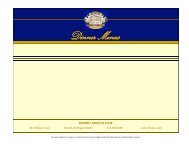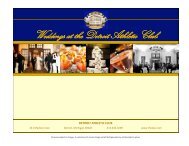Detroit and the Civil War Detroit and the Civil War Detroit and the ...
Detroit and the Civil War Detroit and the Civil War Detroit and the ...
Detroit and the Civil War Detroit and the Civil War Detroit and the ...
Create successful ePaper yourself
Turn your PDF publications into a flip-book with our unique Google optimized e-Paper software.
Audubon<br />
exhibit nests in<br />
Gr<strong>and</strong> Rapids<br />
By Joseph Cabadas<br />
The name Audubon is linked to <strong>the</strong> study of birds much<br />
like Webster is linked to dictionaries, Edison to<br />
electricity or Ford to cars.<br />
John James Audubon was a pioneer in <strong>the</strong> 19th century when<br />
he decided to create <strong>and</strong> publish his full color, life-size drawings<br />
of American birds. His work <strong>and</strong> appeal still resonates with <strong>the</strong><br />
public today.<br />
Offering <strong>the</strong> public a unique opportunity to see 30 of<br />
Audubon’s 435 h<strong>and</strong>-colored prints, <strong>the</strong> Gr<strong>and</strong> Rapids Art<br />
Museum (GRAM) is hosting <strong>the</strong> “Birds of America: Audubon<br />
Prints from Shelburne Museum” on an extended show until Aug.<br />
14.<br />
The exhibit includes historical highlights of Audubon, a video<br />
presentation of all his original watercolor studies, an etching<br />
demonstration display <strong>and</strong> h<strong>and</strong>-coloring activities.<br />
“Audubon is one of <strong>the</strong> three greatest American artists of <strong>the</strong><br />
19th century,” said Richard Axsom, GRAM senior curator of<br />
prints <strong>and</strong> photographs. “What Audubon did was revolutionary.<br />
In Birds of America, he was <strong>the</strong> first artist to paint birds full scale<br />
<strong>and</strong> to present <strong>the</strong>m in <strong>the</strong>ir natural habitat <strong>and</strong> in natural action.<br />
Although that sounds like what one would do, at <strong>the</strong> time it was<br />
very radical. The ornithological<br />
illustrations before Audubon’s time<br />
were like mug shots showing frontal<br />
<strong>and</strong> profile, but not necessarily in a<br />
l<strong>and</strong>scape <strong>and</strong> not in any action.”<br />
The public became excited about<br />
how Audubon vividly portrayed <strong>the</strong><br />
birds’ plumage <strong>and</strong> physical<br />
characteristics along with backgrounds<br />
that showed recognizable l<strong>and</strong>scapes<br />
<strong>and</strong> city scenes. His name <strong>and</strong> appeal<br />
survives thanks to <strong>the</strong> ubiquitous<br />
Audubon societies, bird stamps <strong>and</strong><br />
calendars.<br />
Living in Haiti, plus France <strong>and</strong> a<br />
family farm in Pennsylvania when he<br />
was young, Audubon was <strong>the</strong> son of a<br />
French sea captain <strong>and</strong> a Creole<br />
mo<strong>the</strong>r. He was fascinated by birds at a<br />
38 DAC NEWS JULY 2011<br />
John James Audubon’s “Herring Gull...View of <strong>the</strong><br />
Entrance into St. Augustine” (plate CCXCI; 1831).<br />
Courtesy Shelburne Museum.<br />
John James Audubon’s “Carolina Turtle Dove” (plate XVIII; 1827).<br />
Courtesy Shelburne Museum.<br />
young age <strong>and</strong> by <strong>the</strong> 1820s decided to document all <strong>the</strong><br />
American birds that he could. It became a 17-year-long project<br />
as he traveled up <strong>and</strong> down <strong>the</strong> East Coast from Labrador in <strong>the</strong><br />
north to Florida’s Key West in <strong>the</strong> south, <strong>the</strong> hinterl<strong>and</strong>s such as<br />
Kentucky, or along <strong>the</strong> Ohio River, down <strong>the</strong> Mississippi <strong>and</strong><br />
<strong>the</strong> Mississippi Delta.<br />
In his travels, Audubon had to kill some<br />
of <strong>the</strong> specimens he wanted to illustrate,<br />
wire <strong>the</strong>m into action poses <strong>and</strong> create <strong>the</strong><br />
drawings almost on <strong>the</strong> spot because <strong>the</strong><br />
colors of <strong>the</strong> fea<strong>the</strong>rs began to fade within<br />
hours of <strong>the</strong> birds’ deaths.<br />
Using <strong>the</strong> largest printing paper available<br />
at <strong>the</strong> time, he turned to engraver Robert<br />
Havell of Engl<strong>and</strong> which resulted in a<br />
creation of a subscription-based series of<br />
books of h<strong>and</strong>-colored engravings that<br />
wasn’t finished until 1838.<br />
“Every two months subscribers would<br />
get five prints in a packet,” Axsom said.<br />
“When he was done, <strong>the</strong> (435) prints were<br />
bound into four volumes… Not only were<br />
<strong>the</strong> engravings expensive, but so was <strong>the</strong><br />
complete set. In 1938, Birds of America<br />
(<strong>the</strong> Havell edition) sold for $1,000.”


